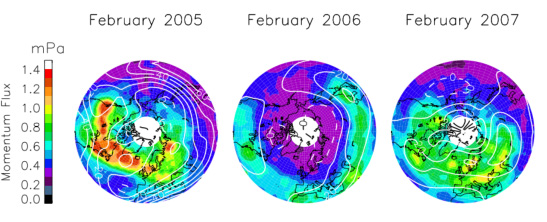Analysis of the HIRDLS measurements, together with analysis of European Centre for Medium-Range Weather Forecasting zonal winds, provide direct evidence of wind filtering of the gravity wave spectrum during this period, with the result that gravity wave amplitude decreases as energy is transferred to the mean flow, and is prevented from propagating upward to the stratopause. This confirms the relationship that was hypothesized from model studies indicating the strong effect that gravity wave drag has on the polar stratopause height.

Polar stereographic monthly means of momentum flux at 10 hPa for February 2005, 2006 and 2007, with ECMWF-derived zonal winds at 50 hPa shown in white contour lines. Note the extended region of negative zonal winds at high latitudes in 2006, in contrast to 2005 and 2007.
Credit : Wright et al. (2010), High Resolution Dynamics Limb Sounder measurements of gravity wave activity in the 2006 Arctic stratosphere, J. Geophys. Res., 115, D02105, doi:10.1029/2009JD011858.
7.13.2011